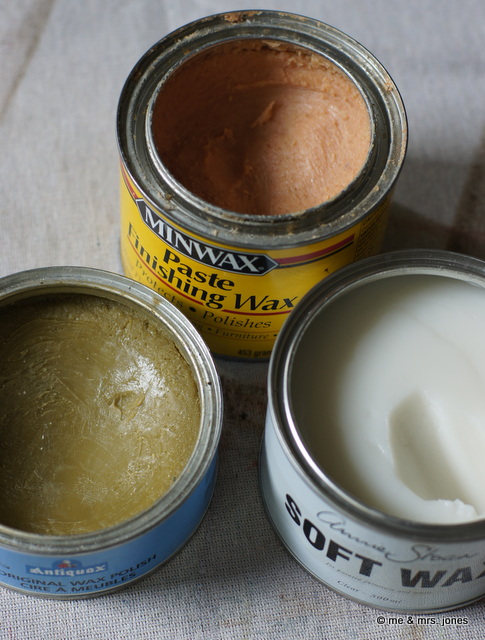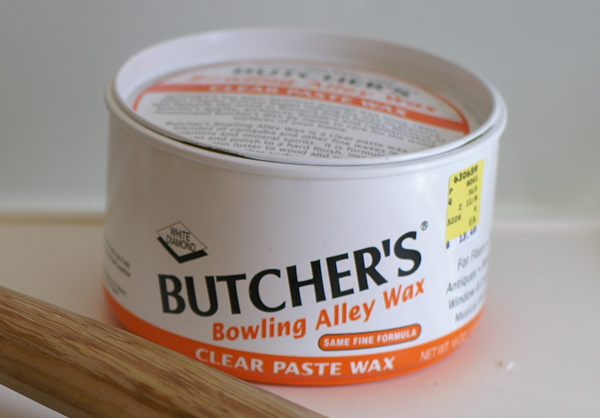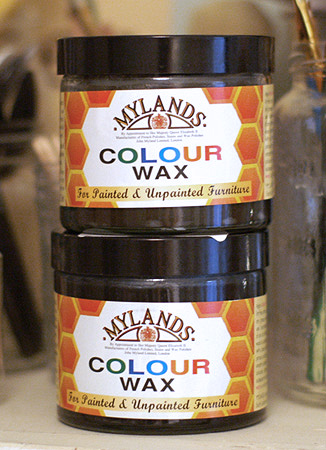
mrs. jones recently fielded a question on using wax as part of a painted finish (with standard latex/acrylic/alkyd paint), and wanted to share a little more information in case others might have the same query. wax (as you know) is a petroleum-based product, and so acts as a fantastic sealer and protective layer on top of paint. but because it is so, well, waxy, paints and glazes will not adhere over it, and so it must be your final layer (or act as a “resist layer”…more soon on this technique.) (and if you’re using chalk paint™ decorative paints by annie sloan, or miss mustard seed’s (or other) milk paint, please follow waxing instructions particular to those wonderful mediums, since the method is a bit different.)
it’s simple to use wax over paint to protect, add sheen, and give that old-fashioned furniture feel. for an application like this, i (obviously) love annie sloan’s clear wax…it’s butter-soft, has a very low solvent content, and is truly clear (to illustrate, see photo above, and read below.) minwax’s paste finishing wax is also a decent one if you need to put your hands on a more widely available choice. myland’s and antiquax are both excellent. the list goes on and on..anyway:
with paste wax, run the bristles of a chip brush ( the 2″ size is perfect for this, as they fit neatly into most can openings) over the wax, and then brush in quick, short strokes over the surface, following your painted brushstrokes, and bearing down to spread the wax evenly. you’ll feel the brush begin to “pull” as it runs low and needs to be reloaded. let the wax dry – depending on your humidity levels, this can take 20 minutes to 4 hours – and then buff/polish with a soft lint-free cloth, like an old t-shirt, folded to the size of your hand. (if you’re using annie sloan soft wax, you can use a firm-bristled brush or a cloth for application. wipe the excess wax back while it’s still wet, and then leave it to dry, buffing later, or even the next day.) for buffing, cut-up oxford cloth shirts are a great tool, as are bird’s-eye-weave diapers.
the drawback to most paste waxes is (as shown in the photo at the top) that they can leave behind a hint of a pink-ish or amber tint, which will show on lighter and darker paint colors. over white/light paints, if you can’t easily get annie sloan’s soft wax, bowling alley wax is an option. it goes on very clear, and does not yellow over time. it buffs to a higher shine than plain paste wax…even glossier if you put on a second coat…though it requires more muscle to apply and polish.

tinted waxes (besides the annie sloan dark wax, mylands is hands-down my favorite line, but there are plenty available – your local antique shop will probably stock a great choice, too) give you wax and color in one step. (peek here to see a project using tinted wax on raw wood, and here for a restoration project.) over lighter shades of paint, wax containing a tint such as raw umber, antique pine, or dark brown will leave behind a yummy patina and a nice aged effect. black tinted wax over black paint gives beautiful depth. brush it on as thinly as possible, and if buffing with a cloth doesn’t remove as much as you want or give the desired sheen, try going over the surface very gently, and with the grain, with 0000 steel wool instead*.

(word to the wise: tinted waxes should not be used on a piece that will come into close contact with light-colored fabrics, since there is a chance that some of the pigment might rub off from, say, a dining room chair on to your aunt louise’s new white blouse, or from the bed headboard on to that fabulous ivory pillow sham you just brought home.)
if the wax is too firm to brush on easily, set the whole tin in a pan of hot water to soften it up, or leave it to sit in a sunny window for a little while.
*one other little trick to have up your sleeve is to apply a thin, very sparing dusting of rottenstone to the surface just after you brush on the wax. when you’re ready to buff, the rottenstone acts as a gentle abrasive, bringing up the shine and making the work go a little more quickly. it will leave just a tiny hint of dusty gray behind where you’ve sprinkled it, another great way to “age” a newly painted surface. using a small (1/2″ or 1″) chip brush, dip just the tips of the bristles into the rottenstone, and then tap the brush gently above the waxed surface to distribute the dust. (richard martin, long the king of fabulous painted finishes here in memphis, has a signature look to his work that includes a dusting of rottenstone left in all the right nooks & crannies. it is perfectly gorgeous.)
and, finally, don’t toss your waxed-up chip brush…ziplock-bag it, and keep it for next time. the bristles might become stiff, but will soften up when you start working with it again.
cat says
Stephanie: I have a beast of a china cabinet I am redoing and I am thinking cream (i have mentioned this before I believe) . I think some wax with the rotterstone would “age” it nicely . I like the grey idea. I do not want to “brown” out the white thus would you suggest bowling wax? Thanks
Cat
stephanie says
yes, cat, i think that is the way to go! can’t wait to see how it turns out. xx stephanie
BoxwoodTerrace says
Hi Stephanie – Great advice and thanks so much for the tips. I have tried the wax over paint technique before, but didn’t know about tinted wax, rottenstone and using a brush to apply the wax. Looking forward to your post about “relief” techniques with wax. I still wish we lived near each other so I could hire you!
Deborah
Tom Henman says
I love Liberion Black Bison Wax. Neutral wax goes on clear. Medium Oak is the other one that I keep on hand… I live to mix them to get different shades.
stephanie says
thank you tom, good to know! liberion has lots of fans, i haven’t been able to find it in memphis yet.
Nancy says
Thanks for your great tips! I plan to paint a chair with Annie Sloan paint and use a dark wax to bring out the definition but you mentioned that it could rub off. Any suggestions on how to get the same effect without risking color coming off on someone’s clothes? Thanks.
stephanie says
hi nancy – sorry, i need to edit that to clarify! annie sloan’s dark wax, once it’s buffed and had a few weeks to cure, is not going to budge. on any areas where it will come into contact with clothing, make sure to give it a pretty vigorous polishing…the friction that you’re creating will help speed the hardening of the wax. good luck with your project!
traci says
Just a tip- I was concerned about how stiff my wax brush would get. I wals kept mine in a zip lock bag but I sometimes used the same brush for dark and clear wax….. so after researching, I read to soak it in vegetable oil. I did this and washed well with Dawn (to remove the oil) . The brush was like new. Worked for me..
Maureen says
I made a coffe table out of crates that I stained and then painted a stencil on. Can wax be used to finish it or do you have to use a varnish if there are stained parts to the table?
stephanie says
absolutely! wax is a great sealer over stain. a tinted wax can add even more depth to your finish.
Kathleen says
i am in the midst of painting a great vintage chest with ASCP Old Ochre, and purchased AS Dark Wax to use on it ~ rather sparingly. After buying my supplies, I have seen directions in several places online that I must use clear wax first to “set” the paint. However, it does not appear that you share that same view. It seems to me from here that I could use Minwax, Bowling Alley Wax, or even the AS Dark Wax: am I reading this correctly?
This would be most helpful, since I’m not near the Annie Sloan retailer I used to obtain the clear wax now, nor have I researched a closer source yet ~ I’m right in the middle of this project! It’s unfortunate I didn’t do that research *first!*
stephanie says
hi kathleen – sorry if my post caused you confusion…at the beginning of it, i do try to steer chalk paint® users to specific directions about working with that (wonderful!) product line. other waxes can be used on latex/acrylic or oil-based paints, but chalk paint® is a very different kind of medium.
you definitely need to seal the old ochre with a clear wax first. even if dark wax is applied sparingly, since chalk paint® is absorbent and porous, the dark wax will not go on evenly. the paint is going to grab hold of whatever hits it first, and the rich pigments in the dark wax will discolor the paint and leave streaks.
so, sealing first with a clear wax is crucial, especially on a light color like old ochre. you may substitute another wax for annie’s clear if you can’t put your hands on it right away, but other paste waxes can be hard to brush on over chalk paint® just because of their consistency, so find the softest one you can, like myland’s or briwax. other brands of wax may also contain stronger solvents than what annie uses, and those solvents can damage chalk paint®.
try the retailer search at anniesloanunfolded.com…i hope you can find some of ‘the good stuff’ to get your project done! there are also lots of painted furniture facebook forums…perhaps you could find someone near you willing to share or sell some of annie’s clear wax. if you’re not far from memphis, i can ship you some wax. good luck!
Lisa says
I just recently painted my lower kitchen cabinets. Do you think it would be a good idea to wax them? I’m looking for durability of the paint lasting.
stephanie says
hi lisa – what type of paint did you use? if an oil-based or water-borne enamel, i would not worry about waxing, since the wax won’t be absorbed by those paints, and won’t add much appreciable durability. if your paint is Chalk Paint® or milk paint, you will need to protect the paint with wax or another topcoat, since those paints are porous and absorbent. hope that helps.